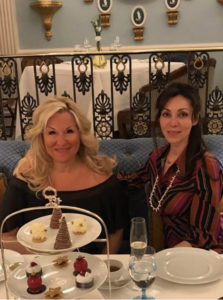
Tea at Lanesborough Hotel with Elizabeth Filippouli photo by Sharon Schweitzer
After water, tea is the second most consumed liquid on the globe; no, it’s not beer! So, in honor of National Hot Tea Month, we are exploring a few global regions where tea is a fundamental part of culture. Just how did tea gain its reputation as a natural cure in our modern world?
- Love you so Matcha in Japan: For the Japanese, tea is an integral part of culture and consumed on a daily basis. However, the Japanese are known to prefer drinking green tea over any other type. So much is the Japanese love for green teas that they have discovered different ways to cultivate it, with different flavors, just like wine or coffee. Some of these different styles of green tea are:
- Ryokucha: A mix of three stages of the green tea plant through harvesting rounds.
- Matcha: The highest quality leaves of the green tea plant are dried and milled creating a powder that is mixed with hot water to make the delicious beverage.
- Konacha: The tea dust or green tea residue makes it the least expensive form.
- Hojicha: Made by roasting the green tea leaches creating a caramel aroma.
- Chai It Up in India: Tea is a big staple of Indian culture, so much so, almost 70% of the tea produced in India is consumed by its own people. Indians are big fans of black tea, like Darjeeling and Assam. The most popular tea is masala chai known for the spices of cinnamon, ginger, black pepper, cloves and cardamom in the flavor.
- Chai Wallahs: Chia is so popular in India there are Chai Wallah tea stores found on many street corners where people gather to socialize, buy, and drink chai tea.
- Oolong in China: It is believed that tea originated in China and was originally consumed as an herbal and natural medicine. Oolong is strongly associated with many religions practiced in China including Buddhism, Taoism and Confucianism. Monks drink tea for its calming effects and peace seeking. With time it became not just a spiritual activity but also cultural and social.
- Gonfu Tea Ceremony: Translated to “making tea with skills,” gonfu is one of the most recognized tea ceremonies in China, where hosts prepare oolong tea as a sign of respect for family and friends.
- British Black Tea: Afternoon tea is popular in the United Kingdom. Tea was first brought to the region around 1840 by the Duchess of Bedford as a simple solution to a common situation: getting peckish between lunch and dinner. Unsurprisingly, many Brits encountered that same struggle, so they sought a light meal between lunch and dinner with quality black tea and a dash of milk alongside finger food like sandwiches, scones or small pastries. Originally, drinking tea was only a high class activity. Soon however, almost everyone implemented it into their daily routines and it has stayed a popular tradition. Pro-tip: There is a misconception that it’s posh to lift your pinky when holding the teacup. It’s actually viewed as elitist.
Many global cultures have found unique ways to enjoy tea on a daily basis. Hot tea is a healthy compliment to life. With thousands of varieties of tea available, there is something for everyone. So, sit back and relax and enjoy a cup of your favorite tea in honor of National Hot Tea Month.
Sharon Schweitzer, J.D., is a diversity and inclusion consultant, cross-cultural trainer, modern manners and etiquette expert, and the founder of Access to Culture. In addition to her accreditation in intercultural management from the HOFSTEDE Centre and the Intercultural Communication Institute, she is an attorney and mediator. Her Amazon #1 Best Selling book in International Business, Access to Asia, won a coveted Kirkus Star, and was named to Kirkus Reviews’ Best Books. She’s a winner of the British Airways International Trade Award at the Greater Austin Business Awards.
#SharonSchweitzer, #AccesstoAsia, #AccesstoCulture, #Cross-CulturalTrainer, #InterculturalCommunication, #International Communication, #HotTeaMonth

Leave A Comment